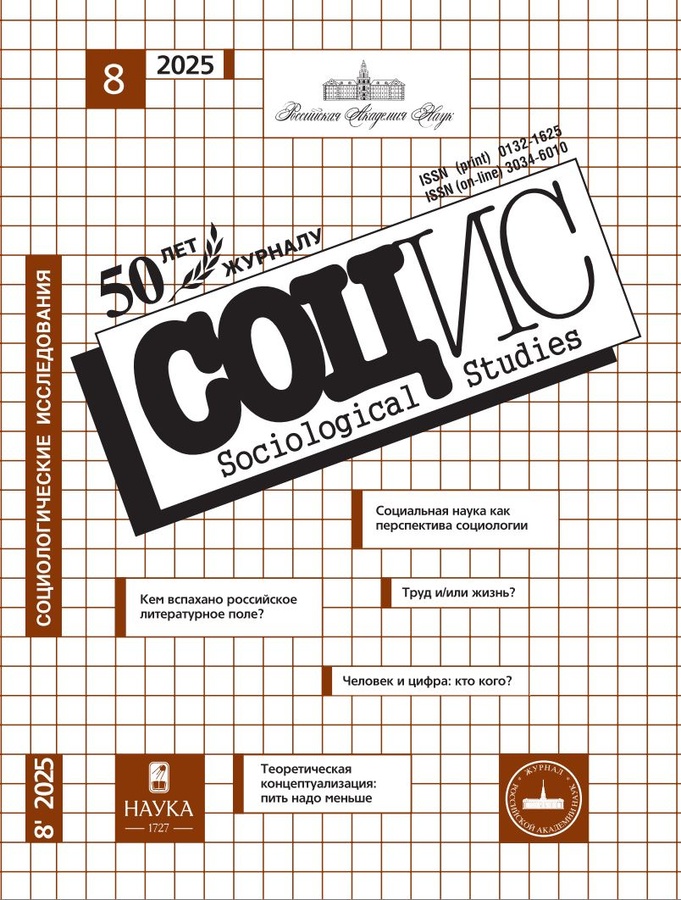Human Potential in the Digitalization Context
- 作者: STRELTSOVA E.A.1, POPOV E.V.1, POLYAKOVA V.V.1
-
隶属关系:
- HSE University
- 期: 编号 8 (2025)
- 页面: 94-107
- 栏目: SOCIAL STRUCTURE. SOCIAL POLICY
- URL: https://snv63.ru/0132-1625/article/view/693343
- DOI: https://doi.org/10.31857/S0132162525080087
- ID: 693343
如何引用文章
详细
The paper examines the readiness of Russian society to live in an increasingly digitalized environment and to function in it in a safe and effective manner. Based on the concept of human potential (HP), the authors proposed an operational model to measure its digital component. It was tested on the data of a representative survey of the Russian population (N = 10,038). This study provides the first estimates of the development of the digital component of HP among Russians and their readiness for life in the ‘digital world’. The results obtained present a more comprehensive picture compared to studies that focus exclusively on access to digital technologies and/or digital literacy. They confirm that various segments of society exhibit differing degrees of adaptation to the realities of digitalization, and almost a fifth of it has no digital component of HP or it is developed at a fairy low level. This blocks their access to the benefits of digitalization that groups with a higher level of digital component of HP derive for themselves. The reasons of this variation include not only socio-demographic characteristics, many of which have long been the focus of social research, but also individuals’ attitudes towards new technologies, their digital skills, and their jobs’ characteristics.
作者简介
E. STRELTSOVA
HSE University
Email: kstreltsova@hse.ru
Moscow, Russia
E. POPOV
HSE University
Email: epopov@hse.ru
Moscow, Russia
V. POLYAKOVA
HSE University
Email: vpoliakova@hse.ru
Moscow, Russia
参考
- Аникин А. В. Человеческий капитал: становление концепции и основные трактовки // Экономическая социология. 2017. Т. 18. № 4. С. 120–156.
- Великая Н. М., Гребняк О. В. Развитие человеческого потенциала в условиях цифровой трансформации в современной России // Вопросы управления. 2023. Т. 81. № 2. С. 33–44.
- Гашенина Н. Как пандемия влияла на рабочие процессы // ФОМ. 2020. URL: https://covid19.fom.ru/post/kak-pandemiya-vliyala-na-rabochie-processy (дата обращения: 28.11.2024).
- Жизнь онлайн: цифровая трансформация российского общества / Под ред. Е. А. Стрельцовой. М.: НИУ ВШЭ, 2025.
- Заславская Т. Н. Человеческий потенциал в современном трансформационном процессе // Общественные науки и современность. 2005. № 4. С. 13–25.
- Иванов О. И. Человеческий потенциал: вопросы теории и методологии исследования // Социологические исследования. 2014. № 6. С. 89–95.
- Иванов О. И. Человеческий потенциал: формирование, развитие, использование. СПб.: СПбГУ, Скифия-принт, 2013.
- Капелюшников Р. И. Сколько стоит человеческий капитал России? Препринт WP3/2012/06. Сер. WP3. Проблемы рынка труда. М.: НИУ ВШЭ, 2012.
- Картузова М. В. Конкурентные стратегии фрилансеров старшего возраста на электронных трудовых платформах // Мониторинг общественного мнения: экономические и социальные перемены. 2022. № 2. С. 207–222.
- Латова Н. В. Досуговые практики российских работников как фактор формирования их человеческого потенциала // Социологические исследования. 2019. № 11. С. 63–72.
- Леонтьев Д. А. Личностный потенциал: оптика психологии // Образовательная политика. 2023. Т. 94. № 2. С. 20–32.
- Попов Д. С., Стрельникова А. В., Григорьева Е. А. Цифровизация российской средней школы: отдача и факторы риска // Мир России. Социология. Этнология. 2022. Т. 31. № 2. С. 26–50.
- Римашевская Н. М., Бочкарёва В. К. и др. Человеческий потенциал российских регионов // Народонаселение. 2013. Т. 61. № 3. С. 82–141.
- Стребков Д. О., Шевчук А. В. Что мы знаем о фрилансерах? Социология свободной занятости. М.: НИУ ВШЭ, 2022.
- Тихонова Н. Е. Российские профессионалы: специфика рабочих мест и человеческого потенциала // Социологические исследования. 2020. № 10. С. 71–83.
- Федотов А. А. Человеческий потенциал и человеческий капитал: сущность и отличие понятий // Экономика и бизнес: теория и практика. 2021. Т. 77. № 7. С 148–155.
- Человеческий потенциал: современные трактовки и результаты исследований / Под ред. Л. Н. Овчаровой, В. А. Аникина, П. С. Сорокина. М.: ВЦИОМ, 2023.
- Dai D. Y. Rethinking Human Potential from a Talent Development Perspective // Journal for the Education of the Gifted. 2022. Vol. 1. No. 43. P. 19–37.
- Druga S., Christoph F. L., Ko A. J. Family as a Third Space for AI Literacies: How do Children and Parents Learn about AI Together? // Proceedings of the 2022 CHI Conference on Human Factors in Computing Systems. 2022. P. 1–17.
- Haleem A., Javaid M. et al. Understanding the Role of Digital Technologies in Education: A Review // Sustainable Operations and Computers. 2022. Vol. 3. P. 275–285.
- Harantová V., Mazanec J. et al. Two-step Cluster Analysis of Passenger Mobility Segmentation during the COVID-19 Pandemic // Mathematics. 2023. Vol. 11. No. 3. P. 583.
- Heckman J. J. Policies to Foster Human Capital // Research in Economics. 2000. Vol. 54. No. 1. P. 3–56.
- Livari N., Sharma S., Ventä-Olkkonen L. Digital Transformation of Everyday Life–How COVID-19 Pandemic Transformed the Basic Education of the Young Generation and Why Information Management Research Should Care? // International Journal of Information Management. 2020. Vol. 55. P. 102183.
- Lee D. W., Lee T. H. Human Capital and Economic Growth Tests Based on the International Evaluation of Educational Achievement // Economics Letters. 1995. Vol. 47. No. 2. P. 219–225.
- Parasuraman A., Colby C. L. An Updated and Streamlined Technology Readiness Index: TRI 2.0 // Journal of Service Research. 2015. Vol. 18. No. 1. P. 59–74.
- Sen A. Development as Freedom (1999). // The globalization and Development Reader: Perspectives on Development and Global Change / Ed. by J. T. Roberts, A. B. Hite, N. Chorev. 2nd ed. Wiley-Blackwell, 2014. P. 525–548.
- Vasenev S. L., Rossinskaya M. V. et al. Influence of Quality of Living-Anthropogenic Impact on the Environment System on Human Potential in Russia // International Journal of Economic Perspectives. 2017. Vol. 11. No. 3. P. 1164–1176.
补充文件









